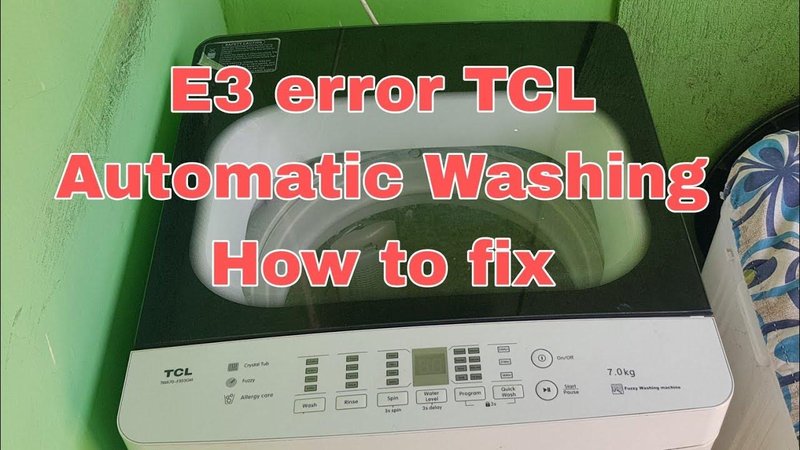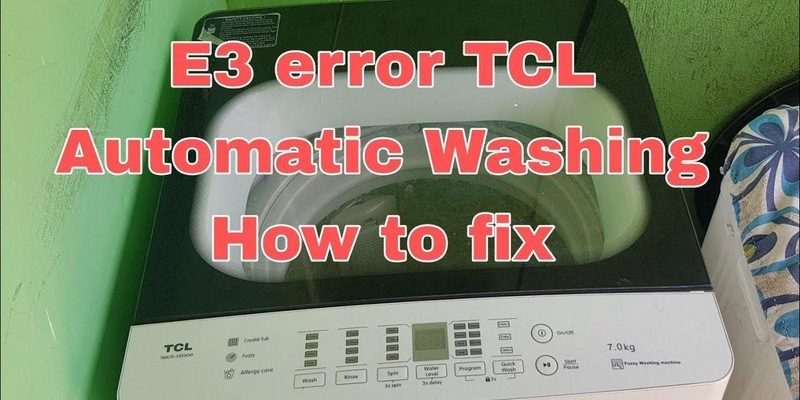
You see, the E3 error code usually indicates a problem with the machine’s drainage system. Imagine trying to pour water out of a bottle with a blocked neck—that’s what your washer goes through when it can’t drain properly. This can be due to a variety of reasons such as a clogged hose or an issue with the pump. Just like you’d unblock the bottle to get the water flowing, there are steps you can take to keep your washing machine running smoothly.
Understanding the E3 Error Code
To tackle the E3 error code, it’s crucial to understand its basics. Think of this code as your washing machine waving a little red flag, indicating that something is wrong with the water flow system. Most often, this error points to drainage issues. It’s like when your kitchen sink gets clogged—the water can’t go where it’s meant to, causing a backup.
The washing machine drum is supposed to empty its water at specific times during a cycle. If it can’t, the machine raises an E3 error as a distress call. This blockage could be due to objects stuck in the drain pump or a kinked drainage hose. It’s like having a straw with something blocking it—all you get is frustration.
Here’s the deal: understanding these causes isn’t just about troubleshooting. It’s about keeping your washing machine in tip-top condition for future use. Regular maintenance can mitigate these issues before they become a problem, saving you time, effort, and the hassle of repairs.
Common Causes of the E3 Error Code
Let’s break down some of the common causes behind this troublesome error code. First, a clogged drain pump filter is one of the usual suspects. This little filter catches all sorts of debris—like coins or lint—that accidentally find their way into your machine. Over time, it can become clogged and impede the water flow. Imagine it like the filter for your sink, catching any solid bits before they cause a blockage.
Another frequent culprit is the drainage hose. If it’s kinked or improperly positioned, it can’t transport the water out of the machine efficiently. Consider it like a garden hose—if someone steps on it or twists it, the water can’t flow freely through it.
Lastly, sometimes the fault lies with the internal workings of the machine itself. Issues with the pump motor or sensor faults can also trigger the E3 error. These are less common but are worth noting if the basic fixes don’t solve the problem.
Steps to Prevent the E3 Error in the Future
Now that you know what causes the E3 error, let’s talk about prevention. Much like how you’d change your oil to keep your car running smoothly, preventive maintenance can save you from the dreaded E3 code. It’s all about keeping things clean and functioning as they should.
Start by regularly checking and cleaning the drain pump filter. Think of this as giving your washing machine a mini-tune-up. Remove any debris, and ensure that water can flow freely. When cleaning the filter, imagine how you’d carefully remove hair from a vacuum roller to ensure it doesn’t get tangled again.
Next, examine the drainage hose for kinks or positioning issues. Make sure it’s straight and clear of any obstructions—this might be as simple as repositioning it. Regular inspections can prevent clogs, just like ensuring your gutters are clear before a storm keeps your roof in good shape.
For deeper maintenance, consider calling in a professional for a thorough check-up once a year. Think of this as your annual health check. A professional can spot issues you might miss, ensuring your machine stays in prime condition.
Maintaining Your Washing Machine for Longevity
Maintaining your washing machine isn’t just about preventing error codes—it’s about extending the life of your appliance, too. It’s like regular dental check-ups; they might seem tedious, but they prevent bigger problems down the line.
Using your washing machine wisely can also help. Avoid overloading it, as this strains the motor and can lead to problems. Imagine stuffing too many clothes into your suitcase; not only does it become hard to close, but the zipper might break.
Finally, read the manual! It sounds simple, but understanding your machine’s specific needs and quirks can help you avoid mistakes that lead to errors. Like getting to know your car’s manual, the washing machine manual is full of handy information you might not realize you need.
In conclusion, preventing the GE washing machine error code E3 is all about being proactive. By understanding its causes and learning how to maintain your machine, you can enjoy hassle-free laundry days and extend the life of your appliance. Remember, proper maintenance is not just a chore; it’s an investment in convenience and peace of mind. So the next time you’re faced with a laundry challenge, you’ll know just what to do!
